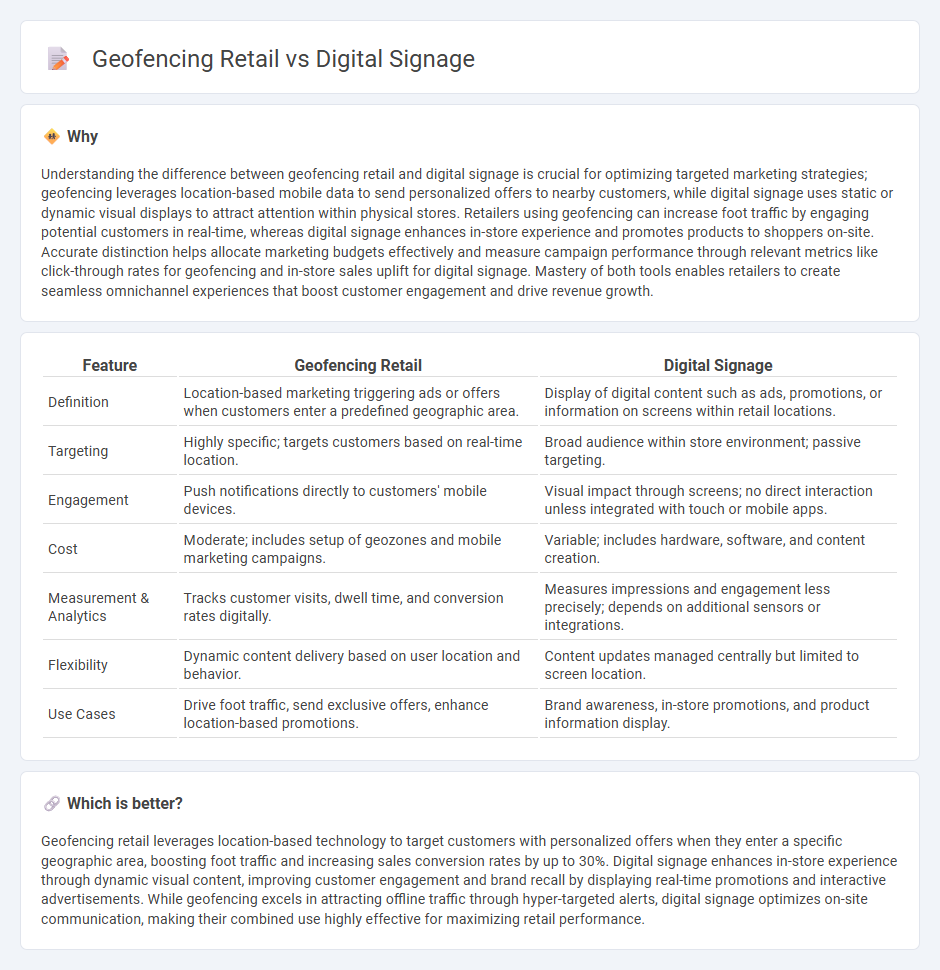
Geofencing retail uses location-based technology to target customers' mobile devices within a predefined area, enhancing personalized marketing and driving immediate in-store visits. Digital signage employs dynamic visual displays to engage shoppers with promotional content, real-time updates, and interactive experiences inside and outside the store. Explore how combining geofencing and digital signage can revolutionize your retail marketing strategy.
Why it is important
Understanding the difference between geofencing retail and digital signage is crucial for optimizing targeted marketing strategies; geofencing leverages location-based mobile data to send personalized offers to nearby customers, while digital signage uses static or dynamic visual displays to attract attention within physical stores. Retailers using geofencing can increase foot traffic by engaging potential customers in real-time, whereas digital signage enhances in-store experience and promotes products to shoppers on-site. Accurate distinction helps allocate marketing budgets effectively and measure campaign performance through relevant metrics like click-through rates for geofencing and in-store sales uplift for digital signage. Mastery of both tools enables retailers to create seamless omnichannel experiences that boost customer engagement and drive revenue growth.
Comparison Table
| Feature | Geofencing Retail | Digital Signage |
|---|---|---|
| Definition | Location-based marketing triggering ads or offers when customers enter a predefined geographic area. | Display of digital content such as ads, promotions, or information on screens within retail locations. |
| Targeting | Highly specific; targets customers based on real-time location. | Broad audience within store environment; passive targeting. |
| Engagement | Push notifications directly to customers' mobile devices. | Visual impact through screens; no direct interaction unless integrated with touch or mobile apps. |
| Cost | Moderate; includes setup of geozones and mobile marketing campaigns. | Variable; includes hardware, software, and content creation. |
| Measurement & Analytics | Tracks customer visits, dwell time, and conversion rates digitally. | Measures impressions and engagement less precisely; depends on additional sensors or integrations. |
| Flexibility | Dynamic content delivery based on user location and behavior. | Content updates managed centrally but limited to screen location. |
| Use Cases | Drive foot traffic, send exclusive offers, enhance location-based promotions. | Brand awareness, in-store promotions, and product information display. |
Which is better?
Geofencing retail leverages location-based technology to target customers with personalized offers when they enter a specific geographic area, boosting foot traffic and increasing sales conversion rates by up to 30%. Digital signage enhances in-store experience through dynamic visual content, improving customer engagement and brand recall by displaying real-time promotions and interactive advertisements. While geofencing excels in attracting offline traffic through hyper-targeted alerts, digital signage optimizes on-site communication, making their combined use highly effective for maximizing retail performance.
Connection
Geofencing retail leverages location-based technology to trigger targeted marketing messages on digital signage when customers enter a predefined geographic area. This integration enhances customer engagement by delivering personalized promotions and real-time offers directly on digital displays within or near the retail environment. Retailers benefit from increased foot traffic and higher conversion rates by combining geofencing precision with dynamic digital signage content.
Key Terms
In-store Displays (Digital Signage)
Digital signage in retail uses dynamic, in-store displays to deliver targeted content, promotions, and real-time information, boosting customer engagement and driving sales. Geofencing complements this by triggering location-based notifications to shoppers' mobile devices when they enter a predefined zone around the store, enhancing personalized marketing strategies. Discover how integrating these technologies can revolutionize your retail experience.
Location-based Notifications (Geofencing)
Location-based notifications through geofencing enable retailers to send targeted promotions and personalized offers directly to customers' smartphones when they enter a predefined geographic area, increasing engagement and driving in-store traffic. Digital signage enhances in-store experiences by displaying dynamic content tailored to real-time customer behavior, but lacks the direct mobile interaction capacity of geofencing. Explore the benefits and applications of geofencing in retail to optimize your location-based marketing strategy.
Customer Engagement
Digital signage enhances customer engagement by delivering dynamic, visually compelling content tailored to in-store environments, increasing dwell time and purchase intent. Geofencing retail leverages location-based technology to trigger personalized promotions and notifications when customers enter a specific area, driving foot traffic and immediate interaction. Explore the strengths of each approach to optimize your retail strategy and maximize customer engagement.
Source and External Links
Digital signage - Wikipedia - Digital signage uses digital display technologies to present multimedia content such as video, images, text, or interactive media in public and private environments for advertising, information, branding, or entertainment, often managed via a networked content management system enabling remote updates and real-time interaction.
What Is Digital Signage? [+ How It Can Help Your Business] - Digital signage displays range from interactive digital directories to advertising monitors and message signs, providing real-time updates, navigation help, and dynamic marketing content across various venues like malls, hospitals, and offices.
Amazon Digital Signage Solutions for Business - Amazon offers the Signage Stick, a plug-and-play device that connects easily to screens and integrates with content management software for professional, scalable digital signage with 4K streaming and secure operation.
 dowidth.com
dowidth.com